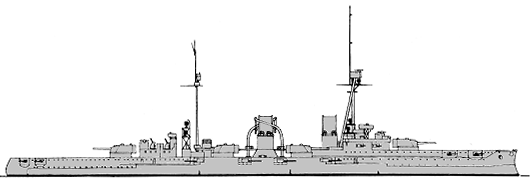
NAVYPEDIA
 Support the project with paypal
Support the project with paypal
Photo

Blücher 1910
Ships
| Name | No | Yard No | Builder | Laid down | Launched | Comp | Fate |
|---|---|---|---|---|---|---|---|
| Blücher | 33 | Kiel KW | 21.2.1907 | 11.4.1908 | 1.10.1909 | TS 1911-1914, sunk 24.1.1915 |
Technical data
| Displacement normal, t | 15842 |
|---|---|
| Displacement full, t | 17500 |
| Length, m | 161.8 oa 161.1 wl |
| Breadth, m | 24.5 |
| Draught, m | 8.56 mean 8.84 deep load |
| No of shafts | 3 |
| Machinery | 3 VTE, 18 Marine boilers |
| Power, h. p. | 32000 |
| Max speed, kts | 24.5 |
| Fuel, t | coal 2510 |
| Endurance, nm(kts) | 6600(12) |
| Armour, mm | belt: 180 - 60, bulkheads: 150 - 80, deck: 70 - 50, barbettes: 180, turrets: 180 - 60, casemates: 140, CT: 250 - 80 |
| Armament | 6 x 2 - 209/42 SK L/45 C/09, 8 x 1 - 149/42 SK L/45 C/09, 16 x 1 - 88/45 SK L/45 C/13, 4 - 450 TT (1 bow, 2 beam, 1 stern) |
| Complement | 853 |
Standard scale images

Blücher 1914
Graphics
Project history
Built under the 1906-7 programme this armoured cruiser was a development of the Scharnhorst class, and although it was known in August 1906 that the British were building the Invincible class battlecruisers, matters had gone too far for Blücher's design to be altered. Except for the small turrets, her general appearance was that of a battleship, with two funnels and goose-neck cranes. A tripod mast, the first in any German ship, was fitted in 1913. Freeboard at normal load was approximately 8.2m forward, 5.5m amidships and 4.6m aft and GM is given as 1.63m.
The main turrets were disposed with 2 on either beam giving an 8-gun broadside and the Drh LC/06 mountings were of short trunk type with fixed working chambers; elevation was 30°. The two forward beam turrets were supplied by central ammunition rails from magazines below those for the after beam turrets and this arrangement was to prove disastrous. The 15cm guns were in a main deck battery and the TT at bow, stern and forward on either beam.
There were 5 boiler rooms and on the mile 43,886ihp = 25.86kt was obtained. Legend coal was 885 tons. As usual at that time in German ships trials were lengthy and began on 1 October 1909. The Blücher was used for gunnery experiments before 1914. At the Dogger Bank a 343mm shell from Princess Royal at 17-19km pierced the armour deck and ignited charges on the ammunition rails causing a disastrous fire, while splinters holed the main steam pipe in No 3 boiler room. In spite of much other damage she proved hard to sink and was probably hit by a total of about 50 heavy shells and 2 533mm torpedoes.
Ship protection
The belt tapered to 120mm at the lower edge and main deck with 80-110mm forward and aft of the end barbettes. The turrets had 180mm faces, 140mm sides, 150mm rears and 80-60mm roofs, and the armour deck was 30mm amidships with 50mm slopes, 50mm forward and 70-60mm aft. A 30mm torpedo bulkhead extended between end barbettes.
Modernizations
None.
Naval service
The Blücher was used for gunnery experiments before 1914. At the Dogger Bank a 343mm shell from Princess Royal at 17-19km pierced the armour deck and ignited charges on the ammunition rails causing a disastrous fire, while splinters holed the main steam pipe in No 3 boiler room. In spite of much other damage she proved hard to sink and was probably hit by a total of about 50 heavy shells and 2 533mm torpedoes.
 HOME
HOME FIGHTING SHIPS OF THE WORLD
FIGHTING SHIPS OF THE WORLD GERMANY
GERMANY CRUISERS
CRUISERS BLÜCHER armoured cruiser (1910)
BLÜCHER armoured cruiser (1910)
